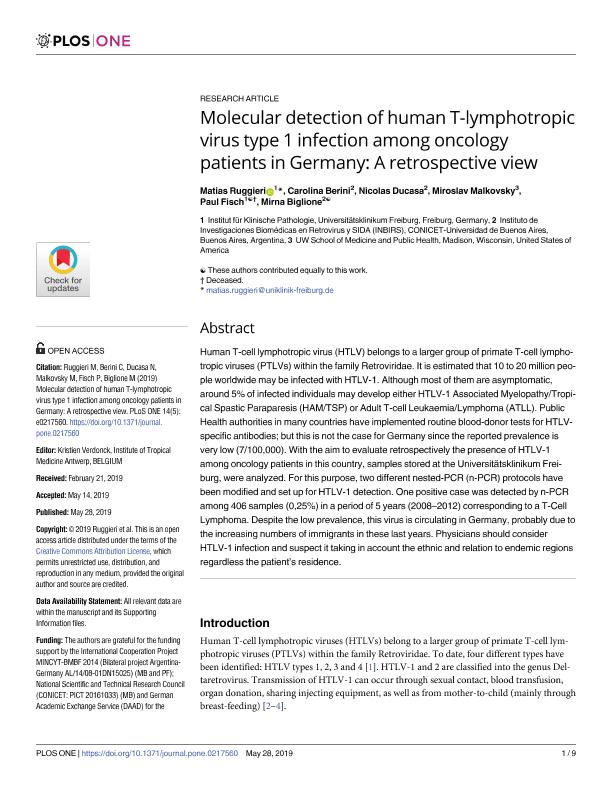Artículo
Molecular detection of human T-lymphotropic virus type 1 infection among oncology patients in Germany: A retrospective view
Ruggieri, Matias ; Berini, Carolina Andrea
; Berini, Carolina Andrea ; Ducasa, Nicolás; Malkovsky, Miroslav; Fisch, Paul; Biglione, Mirna Marcela
; Ducasa, Nicolás; Malkovsky, Miroslav; Fisch, Paul; Biglione, Mirna Marcela
 ; Berini, Carolina Andrea
; Berini, Carolina Andrea ; Ducasa, Nicolás; Malkovsky, Miroslav; Fisch, Paul; Biglione, Mirna Marcela
; Ducasa, Nicolás; Malkovsky, Miroslav; Fisch, Paul; Biglione, Mirna Marcela
Fecha de publicación:
05/2019
Editorial:
Public Library of Science
Revista:
Plos One
ISSN:
1932-6203
Idioma:
Inglés
Tipo de recurso:
Artículo publicado
Clasificación temática:
Resumen
Human T-cell lymphotropic virus (HTLV) belongs to a larger group of primate T-cell lymphotropic viruses (PTLVs) within the family Retroviridae. It is estimated that 10 to 20 million people worldwide may be infected with HTLV-1. Although most of them are asymptomatic, around 5% of infected individuals may develop either HTLV-1 Associated Myelopathy/Tropical Spastic Paraparesis (HAM/TSP) or Adult T-cell Leukaemia/Lymphoma (ATLL). Public Health authorities in many countries have implemented routine blood-donor tests for HTLVspecific antibodies; but this is not the case for Germany since the reported prevalence is very low (7/100,000). With the aim to evaluate retrospectively the presence of HTLV-1 among oncology patients in this country, samples stored at the Universitä tsklinikum Freiburg, were analyzed. For this purpose, two different nested-PCR (n-PCR) protocols have been modified and set up for HTLV-1 detection. One positive case was detected by n-PCR among 406 samples (0,25%) in a period of 5 years (2008-2012) corresponding to a T-Cell Lymphoma. Despite the low prevalence, this virus is circulating in Germany, probably due to the increasing numbers of immigrants in these last years. Physicians should consider HTLV-1 infection and suspect it taking in account the ethnic and relation to endemic regions regardless the patient´s residence.
Archivos asociados
Licencia
Identificadores
Colecciones
Articulos(INBIRS)
Articulos de INSTITUTO DE INVESTIGACIONES BIOMEDICAS EN RETROVIRUS Y SIDA
Articulos de INSTITUTO DE INVESTIGACIONES BIOMEDICAS EN RETROVIRUS Y SIDA
Citación
Ruggieri, Matias; Berini, Carolina Andrea; Ducasa, Nicolás; Malkovsky, Miroslav; Fisch, Paul; et al.; Molecular detection of human T-lymphotropic virus type 1 infection among oncology patients in Germany: A retrospective view; Public Library of Science; Plos One; 14; 5; 5-2019; 1-9
Compartir
Altmétricas



